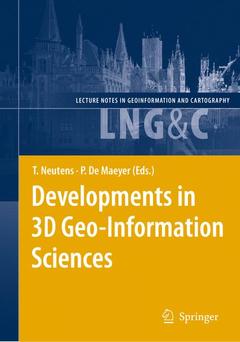Developments in 3D Geo-Information Sciences, 2010 Coll. Lecture Notes in Geoinformation and Cartography
Coordonnateurs : Neutens Tijs, de Maeyer Philippe

Covers the most recent research in the field of 3D Geoinformation with respect to data collection and modelling, data management, data analysis and visualisation
Includes supplementary material: sn.pub/extras
Date de parution : 03-2012
Ouvrage de 219 p.
15.5x23.5 cm
Disponible chez l'éditeur (délai d'approvisionnement : 15 jours).
Prix indicatif 158,24 €
Ajouter au panierDate de parution : 10-2009
Ouvrage de 219 p.
15.5x23.5 cm


